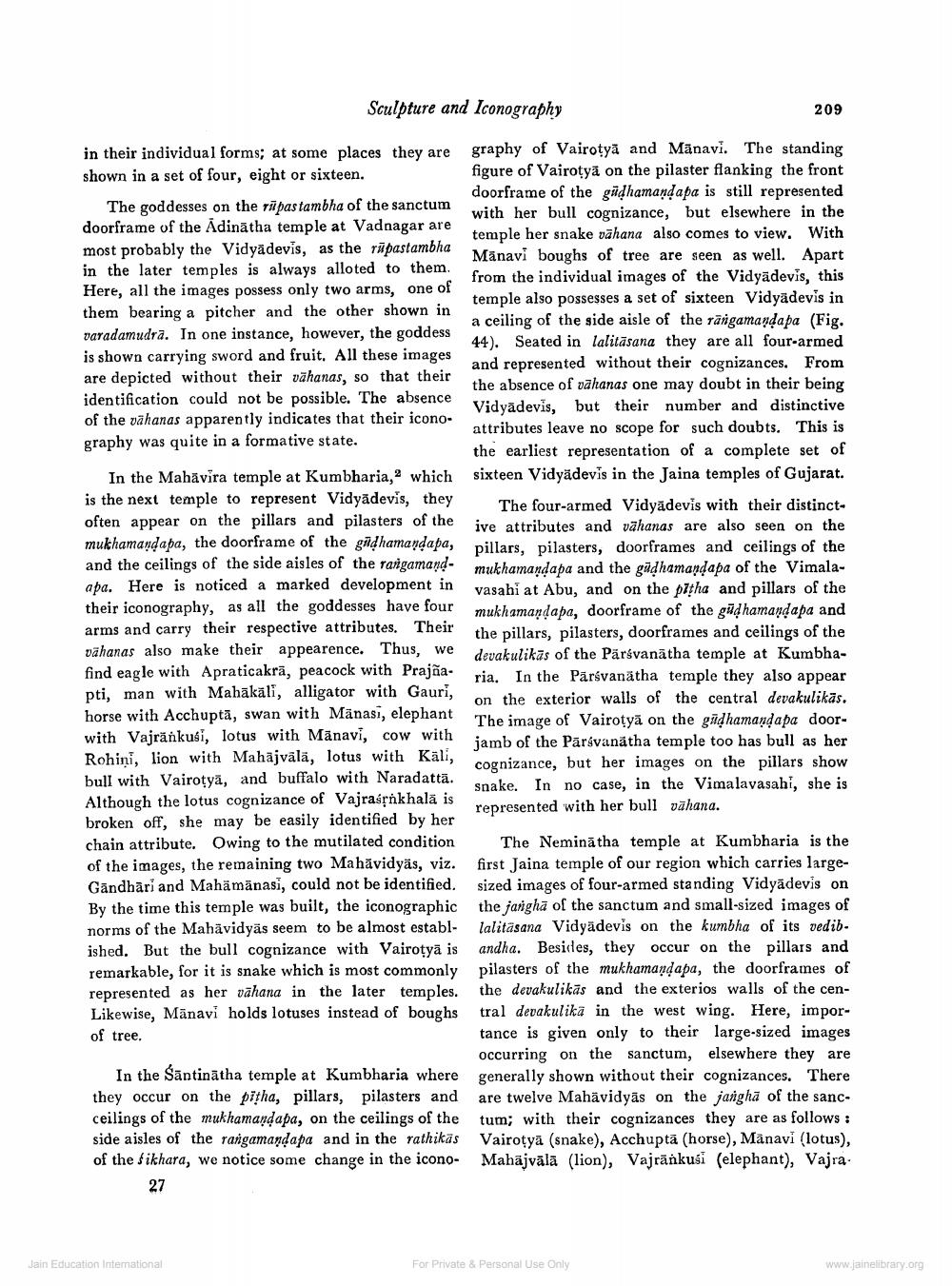________________
Sculpture and Iconography
209
in their individual forms; at some places they are graphy of Vairotyä and Manavi. The standing shown in a set of four, eight or sixteen.
figure of Vairotyā on the pilaster flanking the front
doorframe of the gūdhamandapa is still represented The goddesses on the rūpas tambha of the sanctum
with her bull cognizance, but elsewhere in the doorframe of the Adinātha temple at Vadnagar are
temple her snake vähana also comes to view. With most probably the Vidyadevis, as the räpastambha
Mānavi boughs of tree are seen as well. Apart in the later temples is always alloted to them.
from the individual images of the Vidyādevis, this Here, all the images possess only two arms, one of
temple also possesses a set of sixteen Vidyadevis in them bearing a pitcher and the other shown in
a ceiling of the side aisle of the raigamandapa (Fig. varadamudra. In one instance, however, the goddess
44). Seated in lalitāsana they are all four-armed is shown carrying sword and fruit. All these images
and represented without their cognizances. From are depicted without their vāhanas, so that their
the absence of vahanas one may doubt in their being identification could not be possible. The absence
Vidyadevis, but their number and distinctive of the vahanas apparently indicates that their icono
attributes leave no scope for such doubts. This is graphy was quite in a formative state.
the earliest representation of a complete set of In the Mahavira temple at Kumbharia, which sixteen Vidyadevis in the Jaina temples of Gujarat. is the next temple to represent Vidyādevis, they T he four-armed Vidyadevis with their distinctoften appear on the pillars and pilasters of the ive attributes and vahanas are also seen on the mukhamaydapa, the doorframe of the gidhamandapa, pillars, pilasters, doorframes and ceilings of the and the ceilings of the side aisles of the rangamand- mukhamandapa and the güdhamandapa of the Vimalaapa. Here is noticed a marked development in vasahi at Abu, and on the pitha and pillars of the their iconography, as all the goddesses have four
ses have four mukhamandapa, doorframe of the gūdhamandapa and arms and carry their respective attributes. Their the pillars, pilasters, doorframes and ceilings of the vähanas also make their appearence. Thus, we devakulikās of the Pärsvanātha temple at Kumbhafind eagle with Apraticakrā, peacock with Prajña.
ria. In the Pārsvanatha temple they also appear pti, man with Mahakali, alligator with Gauri,
on the exterior walls of the central devakulikās. horse with Acchuptā, swan with Mänasi, elephant
The image of Vairotyā on the gūdhamandapa doorwith Vajrănkusi, lotus with Mānavi, cow with
jamb of the Pārsvanātha temple too has bull as her Rohini, lion with Mahājvāla, lotus with Kali,
cognizance, but her images on the pillars show bull with Vairotyä, and buffalo with Naradatta.
snake. In no case, in the Vimalavasahi, she is Although the lotus cognizance of Vajraírňkhala is
represented with her bull vahana. broken off, she may be easily identified by her chain attribute. Owing to the mutilated condition The Neminātha temple at Kumbharia is the of the images, the remaining two Mahavidyās, viz. first Jaina temple of our region which carries largeGāndhāri and Mahämänasi, could not be identified. sized images of four-armed standing Vidyādevis on By the time this temple was built, the iconographic the jarigha of the sanctum and small-sized images of norms of the Mahavidyās seem to be almost establ- lalitäsana Vidyadevis on the kumbha of its vedib. ished. But the bull cognizance with Vairotyā is andha. Besides, they occur on the pillars and remarkable, for it is snake which is most commonly pilasters of the mukhamandapa, the doorframes of represented as her vāhana in the later temples. the devakulikās and the exterios walls of the cenLikewise, Mānavi holds lotuses instead of boughs tral devakulika in the west wing. Here, imporof tree.
tance is given only to their large-sized images
occurring on the sanctum, elsewhere they are In the Sāntinātha temple at Kumbharia where generally shown without their cognizances. There they occur on the pitha, pillars, pilasters and are twelve Mahāvidyās on the jarghā of the sancceilings of the mukhamandapa, on the ceilings of the tum; with their cognizances they are as follows: side aisles of the rangamandapa and in the rathikas Vairotyā (snake), Acchuptā (horse), Manavi (lotus), of the Sikhara, we notice some change in the icono- Mahājvālā (lion), Vajrāňkusi (elephant), Vajra.
Jain Education International
For Private & Personal use only
www.jainelibrary.org




